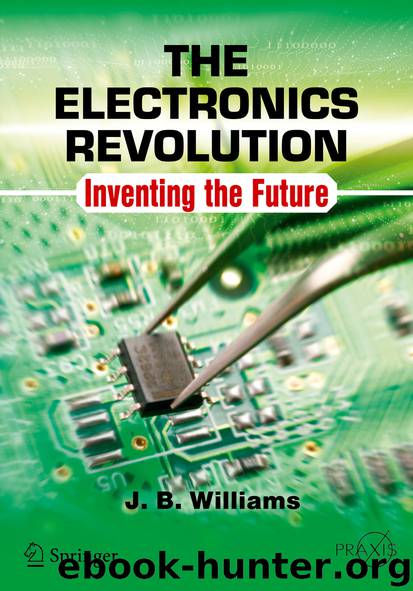The Electronics Revolution by J.B. Williams

Author:J.B. Williams
Language: eng
Format: epub
Publisher: Springer International Publishing, Cham
Some technical improvements in the program storage ROMs helped to increase their usage. First was the obvious idea of the One Time Programmable ROM (OTP). This really was just an EPROM with no window in the device, which made it cheaper to produce. The user could electrically program it but couldn’t change the result. It was suitable for reasonable production runs where the program was fully developed and didn’t need to be changed.
Better still was the electrically erasable programmable ROM or flash EEPROM. This could be erased and rewritten electrically simply by using suitable signals externally which meant that it didn’t need to be removed from its circuit to be reprogramed. Steadily, microprocessors with their memories on board—often known as microcontrollers—moved to this format. With a suitably large program memory built in it contained everything that was needed but was flexible if changes needed to be made. It was the ultimate form.
Though the families of microprocessors available were very successful, there were those who thought that they could be improved. The instruction sets, though satisfactory, had grown rather haphazardly and took at lot of logic to implement. The result was that the designs used large numbers of transistors, ran hot, and were expensive to produce.
The alternative approach was called Reduced Instruction Set Computer (RISC ). It was based on the counterintuitive idea that simpler instructions would run faster, even if more of them were needed. Considerable work was done on the concept, both in academia at Stanford and Berkley universities and at IBM and other companies, but though products were produced and they worked, they didn’t make much impact in the marketplace. 8
In Cambridge in England, the computer company Acorn was looking for a microprocessor to produce the next generation of computers after its very successful BBC computer (see Chap. 17). They looked at all the current offerings but none seemed to have the speed and performance they were looking for. They began to consider making one of their own.
As part of the investigation two engineers, Sophie Wilson and Steve Furber , visited the Western Design Centre in Phoenix, Arizona, where Bill Mensch and a small team was designing a successor to their favorite device, the 6502, in a bungalow in the suburbs. 9 Wilson and Furber had expected to find a large team backed by extensive and sophisticated resources. Their visit showed them that designing a microprocessor didn’t need that and they ought to be quite capable of doing it themselves.
This was quite an optimistic view as IBM had spent months using their large computers to simulate the instruction set of their RISC processor. Not knowing this, Wilson plunged right in and did the whole thing in her head. Furber ’s task was to turn these ideas into logic. Then the chip layout designers took over.
Eighteen months later, in April 1985, the first Acorn RISC Microcomputer appeared. They plugged it in and it worked perfectly, but the one thing that puzzled them was that it appeared to be consuming no power.
Download
This site does not store any files on its server. We only index and link to content provided by other sites. Please contact the content providers to delete copyright contents if any and email us, we'll remove relevant links or contents immediately.
Cecilia; Or, Memoirs of an Heiress — Volume 1 by Fanny Burney(32503)
Cecilia; Or, Memoirs of an Heiress — Volume 2 by Fanny Burney(31913)
Cecilia; Or, Memoirs of an Heiress — Volume 3 by Fanny Burney(31898)
The Great Music City by Andrea Baker(31759)
We're Going to Need More Wine by Gabrielle Union(19004)
All the Missing Girls by Megan Miranda(15784)
Pimp by Iceberg Slim(14438)
Bombshells: Glamour Girls of a Lifetime by Sullivan Steve(14024)
For the Love of Europe by Rick Steves(13627)
Talking to Strangers by Malcolm Gladwell(13297)
Norse Mythology by Gaiman Neil(13281)
Fifty Shades Freed by E L James(13189)
Mindhunter: Inside the FBI's Elite Serial Crime Unit by John E. Douglas & Mark Olshaker(9266)
Crazy Rich Asians by Kevin Kwan(9224)
The Lost Art of Listening by Michael P. Nichols(7456)
Enlightenment Now: The Case for Reason, Science, Humanism, and Progress by Steven Pinker(7274)
The Four Agreements by Don Miguel Ruiz(6704)
Bad Blood by John Carreyrou(6584)
Weapons of Math Destruction by Cathy O'Neil(6220)
